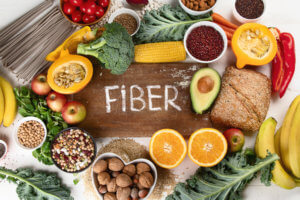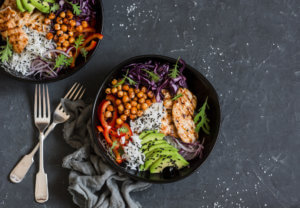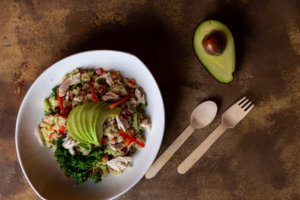When looking to begin a diet program, one thing that is commonly asked is how to look for healthy foods that not only taste great but also satisfy your hunger. Additionally, a question often asked is also why some foods are more filling than others?
Foods that are filling can ward off hunger and help you eat less at the next meal, which is why it is good to incorporate filling, healthy foods into a diet plan. In fact, numerous studies have demonstrated that when people eat foods high in water and fiber and low in fat and processed carbohydrates, they can achieve satisfaction at a lower calorie intake (but the same weight of food consumed) and, therefore, better manage weight. For this reason, “filling foods” should help you lose weight in the long run!
The NJ Diet program is a specialized program utilizes DNA testing to determine your ideal diet and workout plan, taking into account your eating behavior. We use personalized genetic testing can also used by any of your health care providers to help make critical decisions regarding your health. Each individual’s specific needs for essential vitamins, plus many more metabolic factors are assessed genetically to make sure you stay healthy for years to come.
Below we will discuss how healthy foods can be incorporated into your diet, that will satisfy and aid in losing weight!

What Makes A Food Filling?
There are sensors in your mouth, stomach and intestines that send information to your brain to help give you a feeling of fullness. The key is to eat high fiber, high water, and high protein foods because they have been scientifically shown to help you feel full and prevent you from overeating.
A scale called the satiety index measures the effect of feeling fullness and the loss of appetite that happens after eating. Foods are ranked according to their ability to satisfy hunger. Foods that scored higher than 100 were considered more filling, while foods that scored under 100 were considered less filling.
Filling foods tend to have certain characteristics, such as being high in protein or fiber. These types of foods tend to score high on the satiety index. What this means is that eating foods that score higher on the satiety index can help you eat fewer calories overall.
Filling foods tend to have the following characteristics:
- High In Protein: Studies show that protein is the most filling macronutrient.
- High In Fiber: Fiber provides bulk and helps you feel full for longer. Fiber may slow down the emptying of the stomach and increase digestion time
- High In Volume: Some foods contain a lot of water or air. This may help with satiety as well.
- Low In Energy Density: This means that a food is low in calories for its weight. Foods with a low energy density are very filling. They typically contain a lot of water and fiber, but are low in fat.
Additionally, whole, unprocessed foods are also generally more filling than processed foods.

Examples Of Healthy, Filling Foods
The most filling weight loss foods contain protein and fiber, because protein is slow digesting and fiber expands in your stomach to signal your brain that you are full. High fiber foods such as beans, vegetables, and whole grains are low in fat; however, this isn’t true with protein. You need to choose lean protein sources that are low in fat and will help you slim down and preserve your lean muscle tissue.
Some examples of slimming – and filling – foods to add to your diet are listed below:
- Eggs – Eggs are low in calories, a great source of protein and healthy fat, and they are great at curbing your appetite. Hard boiled eggs seem to fill people up the best; however, cooking them other ways will also allow you to enjoy their filling and slimming effects.
- Oatmeal – Oatmeal contains a slow digesting fiber called beta-glucan that will help you feel and stay full for several hours. It also contains protein and healthy fat.
- Nuts – Favorite weight loss nuts are almonds, walnuts, and pistachios. Nuts are a great snack or a great addition to oatmeal, salads or yogurt. They provide protein, fiber and healthy fats. It is important to note, however, that nuts are high in calories, so overeating them can preclude you from losing weight.
- Chia Seeds – Chia seeds have a perfect combination of nutrients (protein and fiber) to help you feel satiated. Add one tablespoon to yogurt, whole wheat toast, oatmeal, or high fiber cereal.

- Fish – Fish is loaded with high-quality protein and is also rich in omega-3 fatty acids, which are essential fats that we must get from food. Omega-3 fatty acids may increase the feeling of fullness in people who are overweight or obese. Additionally, some studies indicate that the protein in fish may have a stronger effect on fullness than other sources of protein.
- Chicken – One, four ounce chicken breast contains 25 grams of lean protein, no carbs and is very low in fat. Chicken also has one of the highest thermal effects of any food. This thermal effect means your body burns calories when digesting chicken. Always opt for grilled or baked chicken and avoid fried chicken due to its high fat and carbohydrate content.
- Broccoli (cruciferous vegetables) – Broccoli is very low in calories, yet it is very filling! It also contains a detoxifying ingredient called glucoraphanin that is great for your immunity and health. Cauliflower is also a great, filing veggie option.
- Greek Yogurt – Greek yogurt is very thick compared to regular yogurt, and is typically higher in protein. In one study, those who ate the higher-protein Greek yogurt felt full the longest, and were less hungry.

- Legumes -Legumes, such as beans, peas, lentils and peanuts, are loaded with fiber and plant-based protein, yet have a relatively low energy density. This makes them very filling.
- Quinoa – Quinoa supplies both protein and fiber. Unlike most other grains, it delivers complete protein. Use in place of rice or pasta for better filling power.
- Avocado – Rich, creamy avocado is satisfying. While is it high in fat, it is the good kind. Its plant-based fatty acids have anti-inflammatory benefits, which can help ease arthritis and lower risk of heart disease. Plus, half an avocado packs 7 grams of fiber and increases absorption of fat-soluble nutrients.

By focusing on whole foods that fill you up with fewer calories, you may help to lose weight in the long run. Filling foods possess certain qualities – tending to be high in fiber or protein, and have a low energy density – which is why they are successfully incorporated into a healthy eating program.
Additionally, these foods tend to be whole, single-ingredient foods – not processed junk foods, which provides added health benefits.
* * *
As we all know when dieting, the number one obstacle to overcome is hunger! So by incorporating the above super-filling — as well as super-satisfying — foods into your diet, you can watch the pounds melt away!
Taking care of your body to look good and lose weight is important, but it’s not going to matter in the long run if your body is unhealthy. Food is something we need to eat every day, but sometimes when thinking about a new diet we focus only on weight loss and calories, not overall health and nutrition. Taking the necessary steps to ensure our wellness, and fight against diseases, is the best first step when considering an eating plan.

If you are ready to lose weight and get healthier, NJ Diet is here to help! Every factor regulating metabolism, appetite, fat storage & fat burning is carefully energetically tested for success. Using DNA Testing over 40 different factors are assessed genetically. We help you not only keep the fat off, but to stay healthy.
Our program is not only aimed at promoting healthy weight loss, but aims to improve your total wellness — where the side effect is weight loss, but the end result is better overall health and well being!
When you come in for your initial evaluation and consultation at NJ Diet, we will explain how many metabolic factors are assessed to genetically make sure you not only lose the weight, but ensures you keep it off and stay healthy for a lifetime.


